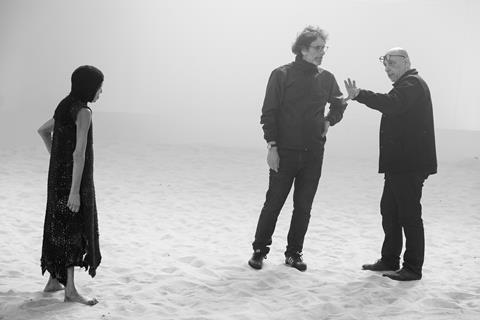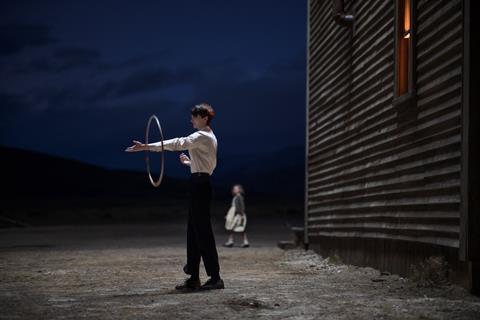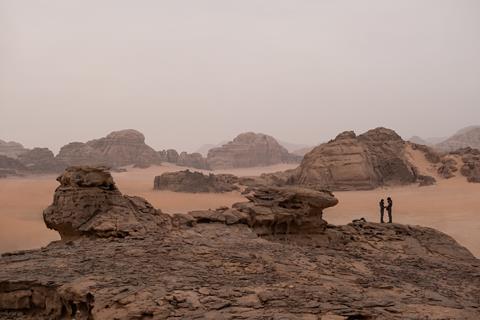All five films nominated for best cinematography are also battling to win best production design. IBC365 explores how, Dune, Nightmare Alley, The Power of the Dog, The Tragedy of Macbeth and West Side Story were shot.
Nightmare Alley
This is Dan Laustsen’s second Oscar nomination and his second working with director Guillermo del Toro (after The Shape of Water). The seductive visuals of Nightmare Alley are like a trap luring Bradley Cooper’s grifter Stanton Carlisle to his dark fate.
“We use smoke, rain and steam a lot in the background particularly when we first see the carnival,” the Danish DP told IBC365. “Steam disappears quickly and it tells you that this story is not quite real, that everything is a little insecure. It’s not quite horror but it contributes to suspense.”

He contrasted scenes set at the seedy travelling carnival with scenes in the city shooting both on large format Arri Alexa 65. Positioning the camera low down in the noir-ish offices and apartments Lausten presents the characters hemmed in by their environment.
Read more Behind the Scenes of Nightmare Alley
”We have a scene with Bradley in a hotel room and use low angle wide shots framing him against the ceiling. He is alone in the blackness. We could have played with light on his face as we do elsewhere… but here we chose to light him totally in silhouette. You don’t need to see everything. You can feel what is going on. To me, that’s a great example of how you can use camera and lighting to tell the story.”
The Tragedy of Macbeth
Joel Coen’s starkly stylised adaptation of the Scottish play is an exercise in merging theatre convention with cinematic language. Pretence at realism is off the table.
“Joel never wanted to deny Macbeth’s origins as a play so immediately that meant abstraction,” understood cinematographer Bruno Delbonnel.
“He was adamant he didn’t want to shoot in a real Scottish castle. Even though he had been talking to theatrical designers he felt he needed a cinematic approach. The imagery and cinematic experience is in dialogue with the rhythms and themes of the text.”
Read more Behind the Scenes: The Tragedy of Macbeth
Presenting the age-old tale in black and white was in keeping with the austerity of this approach and allowed Delbonnel in concert with production designer Stefan Dechant to play with expressionistic light and shadow.

Like the sheer sets, Delbonnel’s camera work is shorn of ostentatious flourish. “Everything is very symmetrical and in line,” he says. “For example, I place the camera in the middle of corridors, always perpendicular to the wall” and moved the camera only when motivated by the characters.
The film is framed in way that deliberately evokes filmmakers such as Fritz Lang. “This goes back to what Joel wanted. With this aspect ratio, when you fill the frame in close up, there is nothing on either side to distract you.”
Production designer Stefan Dechant found the architectural key in a photograph of the Casa Barragan in Mexico City.
He told IBC365, “It’s a black and white, slightly out of focus photo with a tower and two intersecting flat walls. Joel said ‘This feels like Inverness to me. It’s the idea of a castle rather than being a castle.”
The Power of the Dog
Jane Campion’s deconstruction of the myth of Marlboro Man owes more to the austere drama of Robert Bresson than it does to movie Westerns. The director’s brief to costume, production design and camera departments was not to draw attention to any aspect of the filmmaking.
“Simplicity and minimalism is used to craft an incredibly tense story,” explains director of photography Ari Wegner. “Everything in the film from score to colour palette to wardrobe and camera movement is very unshowy.”

Conventional Westerns have the characters roam outdoors. This film is set mostly in dark, gothic and cavernous interiors straining against the pull of the wild outside.
“Coming from Australia, this feeling of being inside in middle of the summer is very familiar to me,” Wegner told British Cinematographer. “The windows were designed to be huge in keeping with the architectural style but since we’d be shooting interiors in a studio (in Auckland) we were challenged how to manage that.”
She explored green screen and over exposing the windows, ultimately settling on billboard-sized printed backdrops of stills taken on location that enabled them to select the time of day and light the set accordingly.
Wegner had the luxury of many weeks familiarising herself with the geography of the location in New Zealand “understanding how the light worked and what the best times of day were.”
Equally important to the film’s psychodrama are the close-up of horse’s manes, rope plaits and toy furniture.
“Those second unit ‘found details’ were things Jane and I had thought about when we storyboarded. Some were conceived as chapter breaks or interludes - images that we thought had an emotional resonance beyond their beauty.”
West Side Story
Uniquely among these nominees, this updated version of the classic musical is shot on 35mm (Kodak Vision3). That’s no surprise given director Steven Spielberg’s staunch adherence to the format - and he has the clout to get the decision greenlit.
Polish cinematographer Janusz Kaminski has been working with Spielberg since 1993, winning the Oscar twice for Schindler’s List and Saving Private Ryan and nominated another four times including for War Horse and Lincoln.
“I came here from another country and I always associated Broadway with glamor and beauty,” Kaminski recalled in interview with IndieWire. “Steven and I both had the same interest in preserving the concept of glossy romanticism that you associate with the ’50s and ’60s. I think it would have been wrong to go the other way and make it gritty and bleach out the colours.”
An early interaction between Maria, her brother Bernardo, and Bernardo’s girlfriend Anita could have been a standard dialogue scene, but by blocking the actors amidst brightly coloured fabrics hanging in the apartment, Kaminski and Spielberg allowed for a vibrant interplay of light, shadow, and movement.

“The fabric almost becomes like a screen where the shadows are being projected,” Kaminski said. “Steven blocks the scene while I’m lighting, and everything grows out of the story and the set.”
During the confrontational fight towards the end of the movie, production designer Adam Stockhausen found a sanitation department salt shed with high windows, situated near the highway off-ramp. Using it as inspiration, Kamiński built an elaborate lighting rig to have a mix of headlights and brake lights shining through at intervals.
“What if the location was just below the overpass, and the cars illuminated the windows as the fight happens?” he said. “And as the fight intensifies, we speed up the lights coming from outside to the point where it becomes this wild visual element of moving lights. There are flares and shadows and it’s this violent fight. Steven wanted to create that sense of emotional disturbance, not just through the actors and music.”
Dune
Dune could have gone south in all sorts of ways but director Denis Villeneuve’s deep understanding of the story, burning since he was a teenager, made this version definitive.
“I remember being totally fascinated by what the novel was saying about nature — the true main character of Dune,” Villeneuve says in the film’s production notes.
It’s a telling line transmitted to his director of photography Greig Fraser who was filming The Mandalorian while in prep for Dune. The director was adamant that he wanted to avoid virtual production in favour of old school location filming including in Jordan’s Wadi Rum.

“Denis wanted to shoot set on real locations – real dusk, dawn, real sets as much as we can,” Fraser explained to IBC365. That included the moment when Paul (Timothée Chalamet) first sets foot on Arrakis. “He arrives on a mission with his father and crew and when he steps out it’s him experiencing that sand for the first time. It’s such a simple idea but feeling this tactility for me was telling of his character. It foreshadows Paul’s connection to this land.”
Read more Behind the Scenes: Dune
Explaining that they wanted “a clarity to the vision” the filmmakers chose to shoot digital, including with IMAX-certified Alexa LF cameras, but nonetheless took the digital negative through an analogue process. This introduced “a real subtle filmic mystery which we couldn’t have repeated had we shot film or digital by itself” and helped simulate the harsh desert environment.
Fraser is prepping Dune: Part Two which may make more use of virtual stages. “For the next Dune maybe we can mix and match shooting volume with real world scenarios. We could literally be shooting in a sandstorm in Abu Dhabi and have our characters rushing for cover inside of a cave [shot in a volume]. Ideally, the audience doesn’t notice there’s any difference in the two shooting environments.”
Read more The Oscar nominations in full



























No comments yet